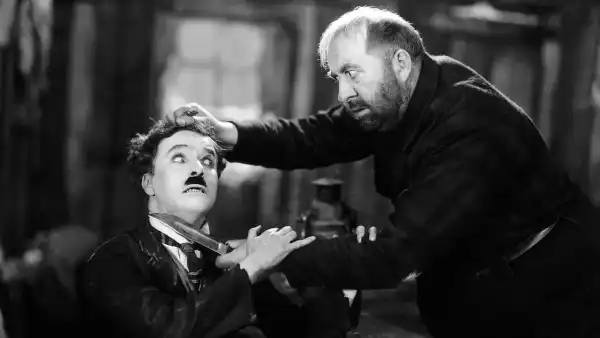
Save this storySave this storySave this storySave this story
The New Yorker’s embrace of cinema got off to a rousing start: its debut issue on February 21, 1925, reviewed F. W. Murnau’s The Last Laugh, a stunning German drama about the hardships of working life that many consider one of the ten greatest films of all time. The paper’s reviewer immediately called Murnau’s film “a magnificent plunge into the innovative aspects of filmmaking,” noting, “Never before has the camera been so pliable an instrument of mood and moment.” This bold judgment set the tone for the paper’s brilliant work in film analysis, whose incredible insight and emphasis on directorial achievement became the hallmark of that first critical year.
The first writer for the film columns was Will Hays Jr., possibly his real name, which creates a grotesque contrast with Will Hays Sr., Hollywood's “moral arbiter” whose censorship guidelines later became known as the Hays Code. The younger Hays wrote ironically about the rules issued by his elder in 1924. Much of his early material consisted of lighthearted film anecdotes (“Give me a long word!” a producer demanded). After the column temporarily disappeared, its return was filled with gossip and sarcasm directed at Hays Sr.: “This year must be the era of comedies – the public is tired of film erotica, which must be eradicated.” The column also mentioned Murnau's upcoming move to Hollywood and admired Ernst Lubitsch's Kiss Me Again, later remade in 1941 as That Uncertain Feeling. A critic who attended a private screening before the premiere claimed that the film surpassed even Lubitsch's brilliant 1924 The Marriage Circle, but expressed his fears: “One shudders at the thought of censorial edits by provincial puritans.”
In the summer, analytical reviews appeared in the columns under the initials “FS” and “FJS.” The writer attended a preview of D. W. Griffith’s comedy “Sally of the Sawdust” in Patchogue, Long Island, predicting that the film would establish W. C. Fields (already a stage star) as “a comic of planetary stature.” Theodore Shane, presumably taking over the column from July 4, was acerbic in the August issue, analyzing Lubitsch’s upcoming film. “The director,” he wrote, “shows human nature as a cocktail of grim humor, vain ambition, momentary whims, and cruel impulses, but justifies the heroes by their remaining humanity.” With a hint of arrogance, Shane concluded, “This picture is as far removed from America as Lubitsch is from the sophistication of Hays.”
Shane's criteria encompassed both the truly significant and the merely entertaining. Reviewing Sally in the Sawdust, he singled out Fields's performance, arguing that he deserved a place in “the pantheon with Chaplin, Lloyd and Keaton.” The critic was not without his mistakes: for example, while admiring the genius of The Gold Rush, he faulted Chaplin for his “Pierrot-like” tearful scenes. “Perhaps he became too self-critical after his election to the Academy,” Shane added sarcastically, reminiscing about the comedian's early farcical work.
His distaste for sentimentality led Shane to criticize even Erich von Stroheim's masterpiece The Merry Widow: “His German genius for paradox deserves adult plots instead of saccharine subtitles.” However, he praised King Vidor's drama The Big Parade for its “whirlwind energy, explosive drive, and dark humor rarely found in modern fads” (this review introduced the “Modern Cinema” section, which still exists today).
In the December issue, Shane published two lists: literary works to be adapted for the screen (for Maupassant he suggested Stroheim, for Hardy – the Swede Sjöström) and the top 10 films of the year, called “the least painful creations of the 1925 fiscal year.” The top ten included:
“The Last Laugh” (Murnau)
“Greed” (Stroheim)
“Forbidden Paradise” (Lubich)
“Kiss Me Again” (Lubich)
“A Decent Guy” (Sutherland)
“The Unholy Three” (Browning)
“Lady Windermere's Fan” (Lubich)
“Pony Express” (Cruz)
“The Gold Rush” (Chaplin)
“The Big Parade” (Vidor)
Most of the positions were taken by auteur projects within the Hollywood system. Interestingly, two of the films on the list (The Unholy Three and The Big Parade) were overseen by Irving Thalberg, the architect of a new production era that limited the power of directors. He cut the nine-hour version of Greed down to two and a half hours, becoming a living illustration of the conflict between directorial auteurism and the standardization of the film industry.
Film coverage was not limited to reviews: The Talk of the Town section (from its first issue) increasingly turned to Charlie Chaplin. A November article told of a curious correspondence with Mark Cross instead of cartoonist Milt Gross. Other articles told of Chaplin and magnate Vanderbilt dressing up as beggars for walks on the Bowery.
Particular attention was paid to the comic's contradictory status: he was perceived as a people's favorite, then as an intellectual artist. A French report by Janet Flanner described the hysterical applause of Parisians at the premiere of The Gold Rush, where Marcel Duchamp “vainly tried to dry his tears of delight with a handkerchief.” Ben Hecht, in a June essay, sneered: “Genius is a neutral territory where the elite and the crowd rub noses.” The screenwriter attributed Chaplin's success not to talent, but to “socialist ideas” and pseudo-intellectualism.
Waldo Frank, in Profile in May, wrote most profoundly about the nature of the phenomenon, portraying Chaplin as torn between delusions of grandeur and fears of inadequacy. The actor, besieged by crowds in Paris, chafed at the lack of attention in New York. Frank quoted his dismay:
I thought my stunts were a technically precise science. Now I see that I have no control over the outcome. I need to study cinematography again.
The critic noted that “Chaplin’s mask contains the multifaceted personality,” but, together with Shane, he worried about “the decline of pure lyricism under the weight of intellectual pursuits.”
Chaplin's first major scandal appeared in the March issue: an article entitled “Hollywood Domestic Troubles” reported on his secret marriage to 16-year-old Lita Grey (the actress's pregnancy led to reshoots of The Gold Rush with Georgia Hale). Without mentioning California's 18-year-old age laws, the author blamed the greed of Grey's mother and “the moral prudes of the Midwest.” The reality was grimmer: Chaplin escaped molestation charges only through marriage. Grey later claimed that her husband joked, “It's better than jail, but not for long.”
Frank, in Profile, diplomatically called one of Chaplin's incarnations “an introspective sensualist,” without hiding his exploitative behavior. It took the film industry a century to begin to combat a system that The New Yorker had once merely noted. ♦
Sourse: newyorker.com






